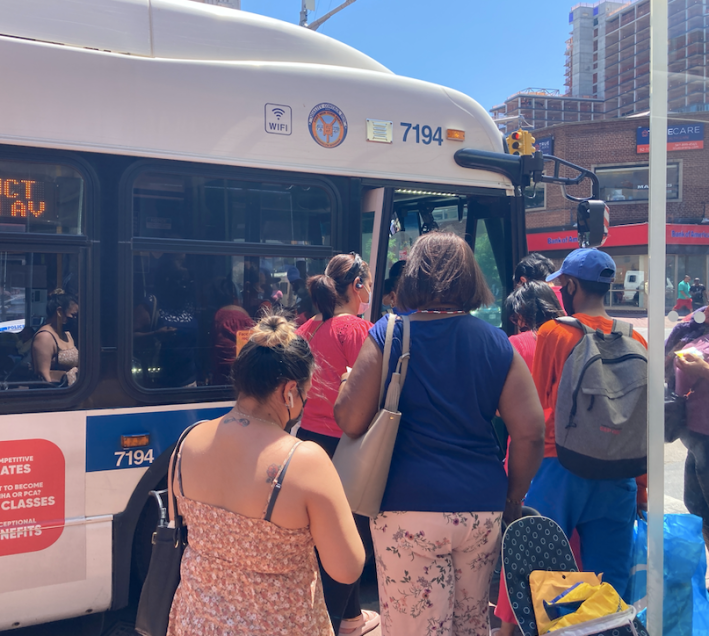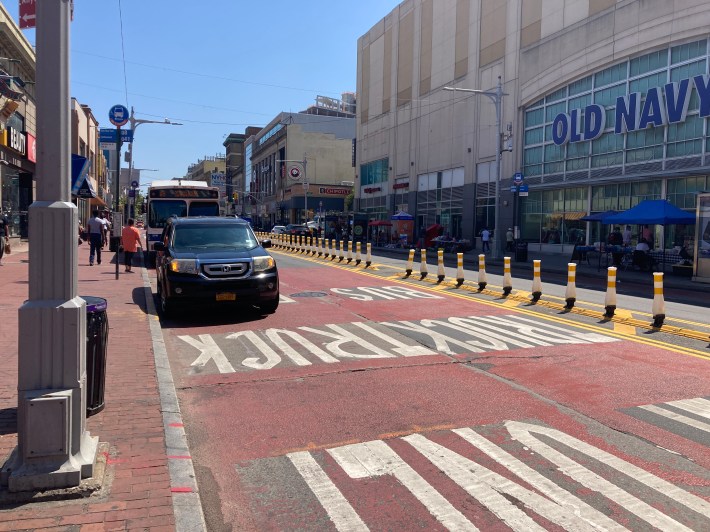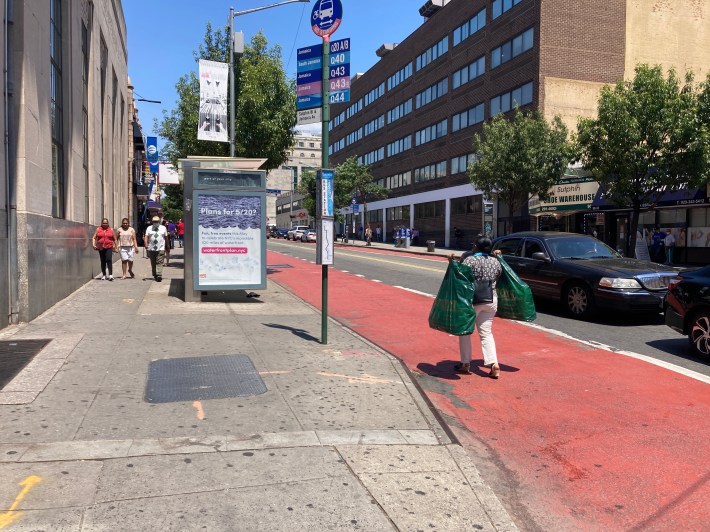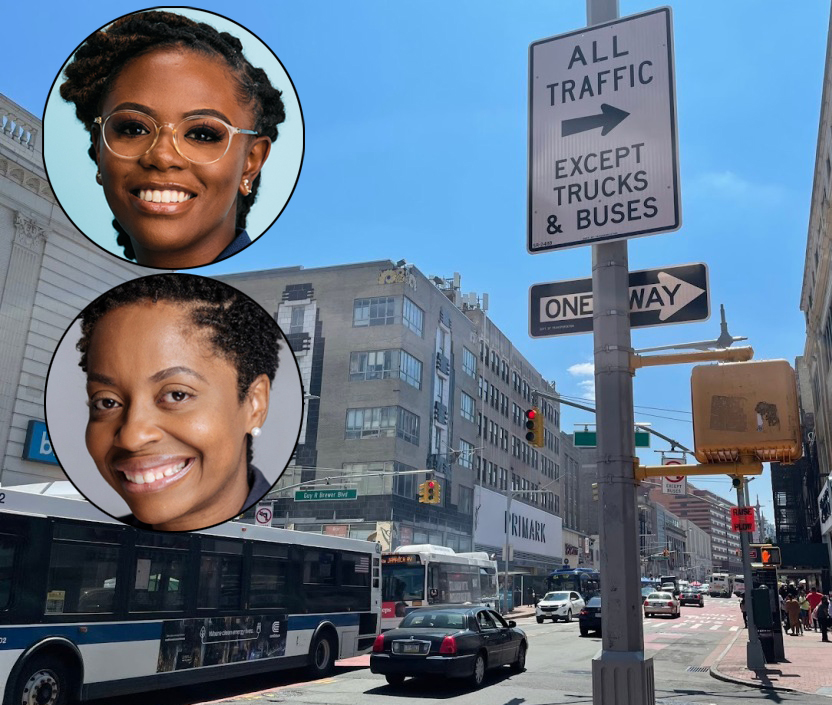Advertisement: Used Dutch Bikes is your one-stop-shop for authentic Dutch bicycles. Choose from classic “grandma bikes” to modern seven-speeds that can haul three kids without breaking a sweat. We carry authentic brands like Gazelle, Batavus, BSP, Burgers, Cortina, and more — available in the USA for the first time!
Nine months after the city rolled out the red carpet on a pair of parallel busways in Downtown Jamaica, two area pols are asking the city to eliminate them, claiming the dedicated bus lanes are inconveniencing drivers and hurting businesses — and the straphangers who were promised faster buses say their commutes have hardly improved at all, either.
The Department of Transportation last November unveiled a one-year pilot on the two 24/7 busways on Archer and Jamaica avenues intended to speed the commutes for more than 250,000 daily bus riders. Elected officials who represented the community at the time were wary, and now, the area's new Council members are fully pushing back.
“Really consider shortening the busway pilot [period] on Jamaica Avenue,” Jamaica Council Member Nantasha Williams told the DOT during a Transportation Committee hearing last month. “When the DOT [does] surveys … they're really only asking targeted questions to bus riders, which I get is the priority, but there is no assessment on the impact of the bus lanes to the businesses that are along the corridors and other people that drive into the area.”
Currently on two-way Jamaica Avenue, between Sutphin Boulevard and 168th Street, thru traffic is restricted to buses, trucks, and emergency vehicles. Drivers are allowed on the corridor, but they must make the first right turn to get off of it — a rule that is nearly entirely ignored, resulting in cars rolling the full length of the thoroughfare, slowing down the buses.
"There's cars running right there. Cars are not supposed to be in the bus lane," said Safia Seivwright, who on Monday afternoon waited more than an hour for the Q56. (That implausible-sounding headway was confirmed by another bus rider at the stop, and the MTA said there were indeed delays that day due to bus operator availability.)

As of this past May, bus speeds on the Q56 reached an abysmal 5.9 miles per hour during peak hours, according to MTA data — far lower than the borough-wide average of 8.4 miles per hour, and lower than the citywide average of 7.7 mph. In May, 2021, before the busways, the Q56 had an average peak speed of 6.3 mph.
For one rider, who said she only ever takes public transportation to Jamaica Avenue, the buses are as bad as they've ever been.
"They're all lousy," said Miriam, who declined to provide her last name.
And on Archer Avenue, an eastbound busway is in effect between 153rd and 160th streets, restricting traffic to just buses and emergency vehicles entirely. The westbound lanes were unchanged. There are no parking or loading zones on the corridor, and the city had installed Jersey barriers to prevent illegal vans from entering the busway.
Those barriers don't always deter drivers. And Jamaica Avenue only has plastic bollards along the corridor, which do little to prevent drivers from entering the busway. Meanwhile, police officers who were patrolling the stretch on foot last week said that enforcing or ticketing illegally parked cars — even those with obscured or fake plates — was above their pay grade. One cop told Streetsblog that he and his fellow officers couldn’t do anything about a car blocking a bus right next to him because that was “outside of” their job.

The Q24, like the Q56, is as slow as it was before the busway was installed. As of May, it inched along at just 7.1 mph during peak hours, slightly slower than in January, and marginally faster than in December, 2021. But it's hovered around 7 miles per hour for the last two years, according to MTA data.
These speed figures are for the entire route of a particular bus, so it's unclear what role the busway stretches play. But the city maintains that the busways are working as intended: to speed up commute times for struggling straphangers. On Jamaica Avenue, bus speeds have increased 34 percent during the evening rush hour, according to DOT. (The agency did not provide comparable figures for Archer Avenue.)
Advocates dismissed the Council members' suggestion that the busway pilot needs to be ended early.
"There's no going back here," said Danny Pearlstein of Riders Alliance. "Bus riders endured miserable service for decades and can't afford to waste another minute to double-parking and other selfish driver behavior."
Williams says she recognizes that systemic issues like “placard abuse” and “double parking” are causing a lot of the congestion, but still says the busway needs a full redo rather than just prohibiting cars 24/7 because, she claimed, it’s hurting businesses and car-owners.
“I'm going to be a broken record … but my community is a car community," she said. "I am happy to look at other modes of transportation. I'm a huge proponent of micro-mobility and trying to figure out ways to actually get more bike lanes and other sorts of modes of transportation and improving the fact that we are a transit desert, but we are a car community. And so my fear is that there's only one metric of success for the bus lane and not looking comprehensively at how it's actually impacting the community."
Nantasha Williams' District:
— Philip Miatkowski (@miatkowski) July 19, 2022
% of drivers with >60 min commute: 19%
% of bus riders with >60 min commute: 42%
District ranks 1st for most weekday bus riders
Brooks-Powers' District:
% of drivers with >60 min commute: 23%
% of bus riders with >60 min commute: 47% https://t.co/vvdFY2Quj0
Williams is right about one thing: her community is full of car owners: census data shows that almost 72 percent of households in Williams's district own at least one car.
But 46 percent of residents commute to work by public transportation, while 41 percent drive alone. And the number of people who reply on public transportation in the area encompassing Downtown Jamaica is even greater — 67.7 percent own at least one car, yet 48 percent of residents take public transportation to work, according to the city data. And both of the busways are adjacent to major transit hubs that connect thousands of riders locally via buses and the E, J and Z subway lines, or the Long Island Rail Road.
But it's unfair that bus passengers are forced to inch along because the bus is stuck behind drivers not following the rules is a nightmare, one of them said.
“I don’t care about street parking, the buses need to move faster,” said Cecilia Blocker, who was waiting for the bus on Jamaica Avenue between 162nd and 163rd streets. “[Drivers] don’t care to follow the rules — they’re constantly standing in no standing zones, which causes congestion. Drivers are also constantly not taking the mandated right turn to get off Jamaica Avenue. It's important that the city prioritizes those who take public transit.”
But owners of mom-and-pop shops along Jamaica Avenue disagree, claiming they’ve lost their most well-heeled customers. The Jamaica Center Business Improvement District conducted a survey last March and claims that 85 percent of responding businesses had lost an average 39 percent of foot traffic as a result of the busway. But a DOT survey of shoppers on Jamaica Avenue conducted in September 2020 found that 42 percent said they typically ride the bus, 25 percent walk, 19 percent take the subway, and just 7 percent drove themselves.
The drivers are clearly a tiny minority of shoppers, but they are well represented by business owners (many of whom drive to work).
“Most customers come by car, they don't come in by the bus,” said Sajid Khan, the owner of a men's suit store on Jamaica Avenue, who claimed that his best customers are “outsiders,” not local customers. "My old customers call and say, ‘I'm sorry, we can’t come, we're going to the other store. We can’t come because of the parking problem.'"
Khan did not provide sales figures to bolster his claim, but his comments echo what both Williams and Council Member Selvena Brooks-Powers, who chairs the council's Transportation Committee and represents a neighboring district, said during the June 28 hearing.
“People cannot access our local businesses,” said Brooks-Powers. That's not entirely true; in the place of the curbside bus lanes on Jamaica Avenue, DOT created space for some new parking, loading zones, and pedestrian zones.
Williams agreed. On Archer Avenue, the city should reconsider the transit improvements because they "work in tandem [with Jamaica Avenue] to create a lot of bottleneck" and "loss of business revenue."
Nonetheless, the "drivers can't shop" argument is often used by local pols and business leaders who claim to be just looking out for the mom-and-pop shops, like on Fifth Avenue in Manhattan and Main Street in Queens.
Former Flushing Council Member Peter Koo once famously misappropriated the Black Lives Matter movement as he expressed his support for Flushing shop owners he claimed would be hurt by the plan for the car-free roadway.
“BLM — that means what? Business Lives Matter!” Koo chanted during a Department of Transportation press conference back when the busway in his district was first proposed in 2020. “BLM! Business Lives Matter!”
The Flushing busway has since gone into effect and has been successful, according to MTA data, which showed that the buses had already sped up by 8 percent to nearly 38 percent. The DOT announced last week that it will become permanent, but the agency is reducing its hours of operation from 24/7 to 6 a.m. to 7 p.m. — a decision that critics say will cause more traffic and likely more crashes, and doesn't make sense, given how successful this busway has been.
One caveat to today's good news: under political pressure, @NYC_DOT was forced to limit the hours of #MainStreetBusway (from 24/7) to 6am to 7pm -- regardless of consequences to transit reliability and street safety. Traffic fatalities as a result of this decision will be noted. pic.twitter.com/RxFD2NSGKb
— John Choe (崔容準 | 최용준) for NYC 🌐 (@johnchoe4nyc) July 15, 2022
The truncation of the Flushing busway will no doubt embolden the calls to end the busway in Jamaica in deference to local shopkeepers. The president of the Jamaica Chamber of Commerce told Streetsblog that he’s gotten dozens of calls from 15 or 20 merchants who have complained that the busway hurts their businesses by preventing deliveries from getting made, and discourages customers from coming to their stores because of the traffic restrictions.
“It has a negative impact, without a doubt,” said Robert Richards. “How can you have a commercial strip that prohibits cars? It kills some of the clientele. The use of private cars has always been strong.”
He says he hasn’t gotten a single positive review.
“But in all fairness, happy people don't always speak up,” said Richards.
Business owners often think a change in the roadway has undermined their sales. It's a common refrain whenever the city puts in a protected bike lane, despite substantial evidence that sales actually increase after the road safety or transit improvement.
Busways: Back to the future?
The latest busway effort by the city DOT is a bit of a back-to-the-future effort to speed transit and boost business. The city’s original, and very successful, busway on Brooklyn's Fulton Street between Boerum Place and Flatbush Avenue, dates back to the 1970s and is lined with shops that, according to the local business group, attract more than 150,000 shoppers every day even though cars are not allowed on the roadway at all.
And rents along the Fulton Mall are some of the highest in the city outside of Manhattan, further evidence that car-free streets do not automatically mean an unfavorable business climate.
Richards of the Jamaica business group, argued that Jamaica Avenue won't experience the same boost because people drive to Jamaica from all over Queens, and even Long Island, to shop.
“Fulton Mall is also a very concentrated population area, too, Queens doesn't have the downtown that Brooklyn does. I think the comparison is quite different,” he said. “The closest competitor is in Nassau County, so they say, ‘I think I’ll just drive to the shopping mall in Nassau County.'”
What’s the fuss about @advocat4justice ? Here in Brooklyn, Fulton Mall has been bussway for 30+ years— and everyone ❤️ it. During my time @DowntownBklyn the local biz would actually complain during bus reroutes off mall cuz they generated so much biz. @BrooklynSpoke @TransAlt pic.twitter.com/O6xQf17PGm
— Shabazz Stuart (@ShabazzStuart) August 15, 2019
A few Jamaica Avenue shoppers that Streetsblog spoke to recently had indeed arrived by car, including from Long Island, but the vast majority said they took public transportation to the commercial strip.

What's the next move?
Queens Borough President Donovan Richards said he agrees with the two Council members that the Jamaica Avenue busway needs to be reworked, but has put up what he believes is a compromise: limiting the busway to weekdays. He also wants the Archer Avenue busway to remain as is. He added that the city must install clearer signs to alleviate confusion about what is and what's not allowed by drivers.
“Adjusting the Jamaica Avenue busway has been a focus of the Downtown Jamaica Improvement Council, and we’ve heard from numerous area small business owners about the impact the busway has had on their businesses,” said Richards. "The Jamaica Avenue busway would best serve the community by operating on weekdays only between 7 a.m. and 7 p.m., allowing for efficient public transit through the corridor at peak hours and ensuring that local businesses have the opportunity to thrive."
It is unclear how a busway that allegedly undermines businesses would suddenly help those businesses thrive if it is still operating during the hours when most businesses are operating. In any event, the city says it will continue the one-year busway pilot until its end, when it will again survey businesses and riders.
“The Jamaica/Archer busways have significantly improved the commutes of nearly a quarter of a million bus riders who travel on these corridors," said Vin Barone, a spokesman for DOT. "Since the pilot launch, DOT has been engaging businesses and is finalizing its spring survey to determine what further adjustments may be necessary."






